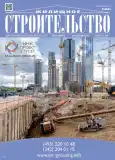Methodology for Obtaining the Core of the Base Model Based on the Results of Experimental Studies of the Interactions of Plates and Stamps with a Pliable Base
- Authors: Shulyat’ev S.O.1
-
Affiliations:
- Research Institute of Bases and Underground Structures (NIIOSP) named after N.M. Gersevanov, Research Center of Construction JSC
- Issue: No 9 (2024)
- Pages: 22-29
- Section: Articles
- URL: https://modernonco.orscience.ru/0044-4472/article/view/642648
- DOI: https://doi.org/10.31659/0044-4472-2024-9-22-29
- ID: 642648
Cite item
Abstract
Article, by way of discussion, provides a description of a technique to determine the core of foundation modelfor the subsequent generation of forces and deformations in the foundation plate on a pliable base by an analytical method. The technique described in the article can also be used to determine the contact model of the base that is closest to these soil conditions, as well as to check the soil conditions for identity from the point of view of soil models. Main goal of conducted research is to obtain relationship between displacements and contact soil stresses, which is an integral Fredholm equation of the 1st kind with the core of soil model described by B.G. Korenev.
Full Text
About the authors
S. O. Shulyat’ev
Research Institute of Bases and Underground Structures (NIIOSP) named after N.M. Gersevanov, Research Center of Construction JSC
Author for correspondence.
Email: shulyatevs@yandex.ru
Candidate of Sciences (Engineering), Leading Researcher
Russian Federation, 6-11, Zagorskiye Dali, Sergiyevo-Posadsky District, Moscow Region, 141367References
- Gorbunov-Posadov M.I., Malikova T.A., Solomin V.I. Raschet konsturktsii na uprugom osnovanii [Calculation of structures on an elastic base]. Moscow: Stroyizdat, 1984. 679 p.
- Kozunova O.V., Bosakov S.V. Development of the theory of nonlinear calculations of orthotropic plates on an arbitrary elastic base. I International Construction Congress. Science. Innovation. Purposes. Construction. Moscow. 2023, pp. 230–231. (In Russian).
- Korenev B.G., Chernigovskaya E.I. Raschet plit na uprugom osnovanii [Calculation of plates on an elastic base]. Moscow: Gosstroyizdat. 1962. 355 p.
- Leonov A.S., Luk’yanenko D.V., Yagola A.G. “Fast” algorithm for solving some three-dimensional inverse magnetometry problems. Matematicheskoe modelirovanie. 2024. Vol. 36. No. 1, pp. 41–58. (In Russian). https:// doi.org/10.20948/mm-2024-01-03
- Matvienko M.P., Dyba V.P., Yukhanaev S.M. Tray tests of reinforced concrete foundation models in the Novocherkassk Scientific School and calculation of their bearing capacity. Informatsionnye tekhnologii v obsledovanii ekspluatiruemykh zdanii i sooruzhenii. Novocherkassk: Lik. 2019, pp. 173–179. (In Russian).
- Ilyichev V.A., Mangushev R.A., Bogomolov A.N., Boldyrev G.G., Gotman A.L. Spravochnik geotekhnika, osnovaniya i fundamenty, podzemnye sooruzheniya [Handbook of geotechnics, foundations and foundations, underground structures]. Moscow: ASV. 2016. 1034 p.
- Travush V.I. Calculation of building structures on a deformable base. Doktor Diss. (Engeneering). Moscow. 1976. 354 p. (In Russian).
- Travush V.I., Shulyat’ev S.O. Determination of the core of the deformable base model based on experimental data. Osnovaniya, fundamenty i mekhanika gruntov. 2024. Vol. 2, pp. 9–14. (In Russian).
- Travush V.I., Shulyat’ev S.O., Baukov A.Yu. Tray research of slab-sand base interaction. Zhilishchnoe Stroitel’stvo [Housing Construction]. 2022. No. 9, pp. 3–11. (In Russian). https://doi.org/10.31659/0044-4472-2022-9-3-11
- Fedorovskii V.G., Bezvolev S.G. Forecast of sedimentation of shallow foundations and the choice of a base model for calculating slabs. Osnovaniya, fundamenty i mekhanika gruntov. 2000. No. 4, pp. 10–18. (In Russian).
- Tsytovich N.A. Mekhanika gruntov [Soil mechanics]. Moscow: Gosstroyizdat. 1963. 638 c.
- Shulyatyev S.O. Optimization of the foundation solution by conducting field experimental studies of the interaction of a plate with a pliable base. Stroitel’stvo i arkhitektura. 2022. Vol. 10. No. 3, pp. 6–19. (In Russian). https://doi.org/10.29039/2308-0191-2022-10-3-1-5
- Shulyatyev S.O. Comparison of the results of tray and field studies of the interaction of a plate with a pliable base. Soil mechanics in geotechnics and foundation engineering. Materials of the international scientific and technical conference. Novocherkassk. 2022, pp. 317–327. (In Russian).
- Shulyatyev S.O. Experimental studies of the operation of a sandy base loaded with a reinforced concrete slab. Solominskiye readings. Materials of the first international scientific conference. Chelyabinsk. 2022, pp. 152–156. (In Russian).
- Shulyatyev S.O. Description of contact stresses and stamp displacements using various approximating functions. Stroitel’naya mekhanika i raschet sooruzhenii. 2024. Vol. 6, pp. 3–10. (In Russian).
- Tikhonov A.N., Goncharskii A.V., Stepanov V.V., Yagola A.G. Numerical methods for solving ill-posed problems [Chislennye metody resheniya nekorrektnykh zadach]. Moscow: Nauka. 1990. 115 p.
Supplementary files













